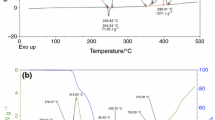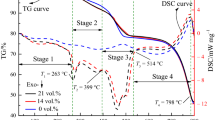Abstract
1-pentyne and 2-hexyne were assessed as replacements for sulphur-bearing odorants in fuel gases, particularly in the view of thermal risks associated with the storage of sulphur-bearing odorants. Both the alkynes were inactive when heated under pressurised nitrogen, but their exothermic behaviour and pressure profiles were found to change when heated in contact with pressurised air. The pressure profiles were considered based on the consumption of oxygen. The exothermic behaviours of 1-pentyne and 2-hexyne were compared both before and after the storage process using differential scanning calorimetry. While both species showed two exothermic peaks before storage, the thermal and pressure load applied during the storage process increased the heat released at low temperatures. Storage under pressurised air influenced the stability of the both the species as well as their exothermic behaviour. The results will help in the use of these odorants and safe handling of fuels containing them.







Similar content being viewed by others
References
Cho CP, Kwon OS, Lee YJ. Effects of the sulfur content of liquefied petroleum gas on regulated and unregulated emissions from liquefied petroleum gas vehicle. Fuel. 2014;137:328–34.
Oka Y, Yoshida T, Kondo T, Ito S, Katoh K. Study on the thermal stability of 2-hexyne, 1-pentyne, ethyl isocyanide, and n-butyl isocyanide as sulfur-free gas odorants. J Therm Anal Calorim. 2010;99:9–14.
Bell S, Guirgis GA, Li Y, Durig JR. Far infrared spectrum, ab initio calculations, and conformational analysis of 1-pentyne. J Phys Chem A. 1997;101:5987–96.
Traetteberg M, Bakken P, Hopf H. Unexpected conformational behavior of gaseous 1-pentyne. J Mol Struct. 1999;509:213–20.
Durig JR, Drew BR. Conformational stability of 1-pentyne from temperature dependent FT-IR spectra of liquid rare gas solutions and ab initio calculations. J Mol Struct. 2001;560:247–59.
Bella S, Zhub X, Guirgisb GA, Durig JR. Infrared and Raman spectra, conformational stability, ab initio calculations of structure, and vibrational assignment of 2-hexyne. J Mol Struct. 2002;616:135–58.
Holme A, Sæthre LJ, Børve KJ, Thomas TD. Carbon 1s photoelectron spectroscopy of 1-pentyne conformers. J Mol Struct. 2009;920:387–92.
Holme A, Børve KJ, Sæthre LJ, Thomas TD. Conformations and CH/π interactions in aliphatic alkynes and alkenes. J Phys Chem A. 2013;117:2007–19.
Hamilton CA, Jackson SD, Kelly GJ. Spence R, de bruin D, competitive reactions in alkyne hydrogenation. Appl Catal A Gen. 2002;237:201–9.
McGregor J, Gladden LF. The role of carbon deposits in the hydrogenation of C5 hydrocarbons. Appl Catal A Gen. 2008;345:51–7.
Leveneur S, Estel L, Crua C. Thermal risk assessment of vegetable oil epoxidation. J Therm Anal Calorim. 2015;122:795–804.
Kumasaki M, Takana K, Otsuka T. Influence of deteriorated solvent on induction period of Grignard reagent formation. J Therm Anal Calorim. 2015;120:633–9.
Zang N, Qian XM, Liu ZY, Shu CM. Thermal hazard evaluation of cyclohexanone peroxide synthesis. J Therm Anal Calorim. 2016;124:1131–9.
Kumasaki M, Sasahara K, Nakajima Y. Thermal sensitivities of triazole derivatives and dinitrobenzene mixtures from the perspective of charge transfer. J Therm Anal Calorim. 2016;. doi:10.1007/s10973-016-5330-0.
Chen WT, Chen WC, You ME, Tsai YT, Shu CM. Evaluation of thermal decomposition phenomenon for 1,1-bis(tert-butylperoxy)-3,3,5-trimethylcyclohexane by DSC and VSP2. J Therm Anal Calorim. 2015;122:1125–33.
Sasahara K, Kumasaki M, Koshi M, Yoshitake H. Electronic interaction and pyrolysis behaviour of adenine and dinitrobenzene mixture. J Sci Technol Energ Mat. 2015;76:20–4.
Sasahara K, Kumasaki M, Date S, Koshi M. Electrostatic interaction and reaction behaviour of 1,2,4-triazole mixture with dinitrobenzene. ZAAC. 2015;641:786–91.
Liessmann G, Schmidt W, Reiffarth S. Data compilation of the Saechsische Olefinwerke Boehlen. Germany; 1995. p. 77.
Belaribi-Boukais G, Ait-Kaci A, Delepine H, Jose J. Total vapor pressures between 263.15 K and 353.15 K and excess enthalpies at 303.15 K of binary mixtures of hex-2-yne + methanol, + ethanol, or + butan-1-ol. ELDATA Int Electron J Phys Chem Data. 1997;3:109–18.
Negadi L, Guetachew T, Ait-Kaci A, Jose J. Static measurements of the total vapor pressure of binary mixtures of dimethyl sulfoxide with hex-1-yne, hex-2-yne, or hex-3-yne at temperatures between 283 K and 363 K. ELDATA Int Electron J Phys Chem Data. 1997;3:91–100.
Trout CC, Badding JV. Solid state polymerization of acetylene at high pressure and low temperature. J Phys Chem A. 2000;104:8142–5.
Gustin JC. Runaway reaction hazards in processing organic nitro compounds. Org Process Res Dev. 1998;2:27–33.
Sales J, Mushtaq F, Christou MD, Nomen R. Study of major accidents involving chemical reactive substances Analysis and lessons learned. Trans IChemE Part B Process Saf Environ. 2007;85:117–24.
Gustin JC. Influence of trace impurities on chemical reaction hazards. J Loss Prev Process Ind. 2002;15:37–48.
Ponzio A, Senthoorselvan S, Yang W, Blasiak W, Eriksson O. Ignition of single coal particles in high-temperature oxidizers with various oxygen concentrations. Fuel. 2008;87:974–87.
Zhang ZH, Balasubramanian R. Effects of oxygenated fuel blends on carbonaceous particulate composition and particle size distributions from a stationary diesel engine. Fuel. 2015;141:1–8.
Acknowledgements
This study was supported by the Ministry of Economy, Trade and Industry Agency of Natural Resources and Energy.
Author information
Authors and Affiliations
Corresponding author
Rights and permissions
About this article
Cite this article
Kumasaki, M., Oka, Y. Risk assessment of potential gas odorants for the storage process. J Therm Anal Calorim 126, 1757–1762 (2016). https://doi.org/10.1007/s10973-016-5742-x
Received:
Accepted:
Published:
Issue Date:
DOI: https://doi.org/10.1007/s10973-016-5742-x




